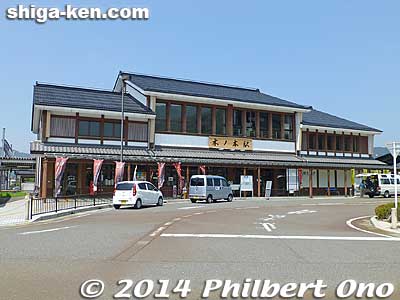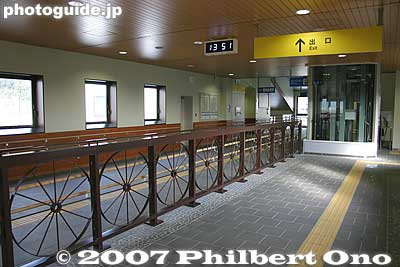Kinomoto Station: Difference between revisions
No edit summary |
No edit summary |
||
| Line 3: | Line 3: | ||
In Oct. 2006, the JR Hokuriku Line switched to direct-current electrification between Nagahama Station and Tsuruga Station (Fukui). This enabled faster and modern Shin-kaisoku (Special Rapid) trains from Kyoto to reach train stations north of Nagahama Station directly (Torahime, Kawake, Takatsuki, Kinomoto, Yogo, and Omi-Shiotsu Stations). Before the switch, passengers had to transfer trains at Nagahama Station to go further north. Anticipating a substantial increase in visitors, new train station buildings were built at Nagahama, Torahime, Takatsuki, and Kinomoto Stations. However, by March 2008, the passenger increase was only 0.5 percent, far below what they had hoped for. | In Oct. 2006, the JR Hokuriku Line switched to direct-current electrification between Nagahama Station and Tsuruga Station (Fukui). This enabled faster and modern Shin-kaisoku (Special Rapid) trains from Kyoto to reach train stations north of Nagahama Station directly (Torahime, Kawake, Takatsuki, Kinomoto, Yogo, and Omi-Shiotsu Stations). Before the switch, passengers had to transfer trains at Nagahama Station to go further north. Anticipating a substantial increase in visitors, new train station buildings were built at Nagahama, Torahime, Takatsuki, and Kinomoto Stations. However, by March 2008, the passenger increase was only 0.5 percent, far below what they had hoped for. | ||
Built slightly north of the old station building and opened in Oct. 2006, the new Kinomoto Station building is modern with a traditional look. Spacious and airy and well designed for function and aesthetics. A lot bigger than the old station building. The train station sign is also wooden like on the old train station. (“Kinomoto” means “origin of wood.”) Next to the exit on the ground floor is a large space selling local products and a tourist information counter. The old and much smaller Kinomoto Station building has been retained as a small exhibition space. Kinomoto Station is where you get off to take a bus to breathtaking and historic [ | Built slightly north of the old station building and opened in Oct. 2006, the new Kinomoto Station building is modern with a traditional look. Spacious and airy and well designed for function and aesthetics. A lot bigger than the old station building. The train station sign is also wooden like on the old train station. (“Kinomoto” means “origin of wood.”) Next to the exit on the ground floor is a large space selling local products and a tourist information counter. The old and much smaller Kinomoto Station building has been retained as a small exhibition space. Kinomoto Station is where you get off to take a bus to breathtaking and historic [https://photoguide.jp/pix/thumbnails.php?album=20 Mt. Shizugatake]. There’s also a [https://photoguide.jp/pix/thumbnails.php?album=465 giant Jizo statue] nearby. Visiting Kinomoto is highly recommended. Note that Kinomoto Station in Japanese (木ノ本駅) uses a different kanji from the one used for the place name Kinomoto (木之本). | ||
[https://www.westjr.co.jp/global/en/ JR West English] | [https://www.westjr.co.jp/global/en/travel-information/timetable/ JR West Timetable and Fare] | [http://www.jorudan.co.jp/english/ Jorudan Timetable and Fare Finder] | [http://photoguide.jp/pix/thumbnails.php?album=465 Nearby attractions] | [https://www.westjr.co.jp/global/en/ JR West English] | [https://www.westjr.co.jp/global/en/travel-information/timetable/ JR West Timetable and Fare] | [http://www.jorudan.co.jp/english/ Jorudan Timetable and Fare Finder] | [http://photoguide.jp/pix/thumbnails.php?album=465 Nearby attractions] | ||
| Line 13: | Line 13: | ||
<table> | <table> | ||
<tr> | <tr> | ||
<td><span class="plainlinks"><a href=" | <td><span class="plainlinks"><a href="https://photoguide.jp/pix/thumbnails.php?album=465" class="external text" title="https://photoguide.jp/pix/thumbnails.php?album=465" rel="nofollow"><img src="https://photoguide.jp/pix/albums/shiga/nagahama/kinomoto/ki209-P1060750.jpg" alt="station photo1" /></a></span> | ||
</td><td><span class="plainlinks"><a href=" | </td><td><span class="plainlinks"><a href="https://photoguide.jp/pix/thumbnails.php?album=465" class="external text" title="https://photoguide.jp/pix/thumbnails.php?album=465" rel="nofollow"><img src="https://photoguide.jp/pix/albums/shiga/nagahama/kinomoto/ki216-IMG_2357.jpg" alt="station photo2" /></a></span> | ||
</td></tr> | </td></tr> | ||
</table> | </table> | ||
| Line 21: | Line 21: | ||
== Related Articles == | == Related Articles == | ||
* [[Shiga Prefecture Transportation]] | * [[Shiga Prefecture Transportation]] | ||
* [ | * [https://shiga-ken.com/blog/2014/05/top-20-train-stations-in-shiga-prefecture/ Top 20 train stations in Shiga] | ||
{{HokurikuLineShiga}} | {{HokurikuLineShiga}} | ||
Revision as of 00:29, 9 May 2019
Kinomoto Station (木ノ本駅) is a JR train station in Nagahama, Shiga Prefecture, Japan on the Hokuriku Main Line operated by West Japan Railway Company (JR West).
In Oct. 2006, the JR Hokuriku Line switched to direct-current electrification between Nagahama Station and Tsuruga Station (Fukui). This enabled faster and modern Shin-kaisoku (Special Rapid) trains from Kyoto to reach train stations north of Nagahama Station directly (Torahime, Kawake, Takatsuki, Kinomoto, Yogo, and Omi-Shiotsu Stations). Before the switch, passengers had to transfer trains at Nagahama Station to go further north. Anticipating a substantial increase in visitors, new train station buildings were built at Nagahama, Torahime, Takatsuki, and Kinomoto Stations. However, by March 2008, the passenger increase was only 0.5 percent, far below what they had hoped for.
Built slightly north of the old station building and opened in Oct. 2006, the new Kinomoto Station building is modern with a traditional look. Spacious and airy and well designed for function and aesthetics. A lot bigger than the old station building. The train station sign is also wooden like on the old train station. (“Kinomoto” means “origin of wood.”) Next to the exit on the ground floor is a large space selling local products and a tourist information counter. The old and much smaller Kinomoto Station building has been retained as a small exhibition space. Kinomoto Station is where you get off to take a bus to breathtaking and historic Mt. Shizugatake. There’s also a giant Jizo statue nearby. Visiting Kinomoto is highly recommended. Note that Kinomoto Station in Japanese (木ノ本駅) uses a different kanji from the one used for the place name Kinomoto (木之本).
JR West English | JR West Timetable and Fare | Jorudan Timetable and Fare Finder | Nearby attractions

| 
|
Related Articles
| Hokuriku Main Line Train Stations in Shiga | ||
| Maibara 米原駅 | Sakata 坂田駅 | Tamura 田村駅 | Nagahama 長浜駅 | Torahime 虎姫駅 | Kawake 河毛駅 | Takatsuki 高月駅 | Kinomoto 木ノ本駅 | Yogo 余呉駅 | Omi-Shiotsu 近江塩津駅 | Shinhikida (Fukui) 新疋田駅 | Tsuruga (Fukui) 敦賀駅 | ||